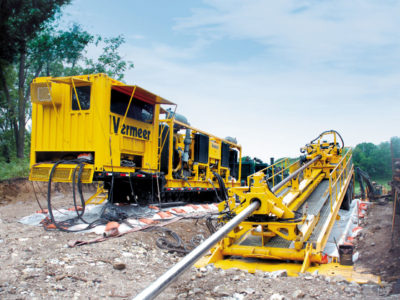So, you’re thinking about switching to a larger drill class and getting into the pipeline business. That’s understandable! There’s a direct link between running utility drills and pipeline drills. Many of the same principles and techniques apply to both, but there are quite a few differences too. You already know pipeline projects are much larger in scale, but they also require some unique solutions.
To help you understand what you need to know before entering into the pipeline industry, we’re going to break it down into three Pro Tips posts, called “Big drill basics.” Today, we’re going to dive into the support equipment you’ll need to have on hand in addition to a horizontal directional drill. There may be more to consider than you think.
When it comes to operating horizontal directional drills, there are many things to consider, but we want to talk about two major considerations that you have to plan for: fluid management and rod transportation. Let’s break those down to help give you a clear idea of what that means for your equipment needs.
More fluid = more equipment + more management
It’s no secret that pipeline drills are built for larger jobs, which can oftentimes mean using more fluid. With pipeline projects, you’re potentially covering more ground, which means more ground engagement, requiring more fluid downhole. Because of that, you need to have a plan in place to handle all of the excess fluid.
“On a lot of utility projects, they might only need one vacuum excavator on the jobsite, since usually they’re dealing with less than 1,000 gallons (3,785 L) of fluid,” explained Marv Klein, Vermeer applications specialist. “For pipeline projects, reclaimers and potentially several vacuum trucks are needed because they’re dealing with thousands of gallons of fluid per day.”
Thousands of gallons of fluid can seem like a big undertaking and likely means more management to maintain jobsite efficiency. This usually leads to creating your own fluid management plan for each project to keep your team on track.
“Small operations generally only need a fluid mixing system and a way to dispose of that fluid,” explained Klein. “But larger operations have to plan for more than that when it comes to fluid management. An economical way is through using a mud reclaimer.”
Bringing in a Vermeer reclaimer can help reduce the amount of fluid and additives used by removing solids and recycling fluids. The fluid that you pump downhole gets processed through the reclaimer and is used over and over again. Overall, a reclaimer can help keep your jobsite efficient by reducing the amount of drilling fluid additives and fresh water you need to complete the pipeline installation. This can be a crucial part of your fluid management plan.
With the rising costs of fluid management and because of the large fluid demands when drilling larger diameter holes, reclaimers/mud recycling systems have become common on many jobsites and should be seriously considered when looking to get into the pipeline industry.
Bigger drills = heavier rods + rod transportation
In addition to having to manage more fluid and equipment, you’ll also have to manage the individual drill rods. This is different than utility drills that carry the rod on the machine.
“The bigger pipeline drills we produce don’t carry the rod on the machine due to the size and weight,” said Klein. “Every rod is handled individually by a lifting mechanism and is put on the drill one section at a time.”
This can be a more time-consuming process than you’re used to and requires more project management from you or your team. For example, now you have to find a way to transport the individual rods to the jobsite.
“This means hauling multiple loads of drill pipe to and from the jobsite,” said Klein. “On a large-scale project, this can take three to five loads, not just one load.”
The logistics and mobilization costs of a pipeline project can add some additional investments to your overall operation, so make sure you’re prepared and have the equipment you need to get the job done right. With more setup time and considerations, it’s essential to have a good equipment plan in place before you start the project.
For more information about reclaimers, pipeline drills and vacuum excavators, contact your local Vermeer dealer.
Vermeer Corporation reserves the right to make changes in engineering, design and specifications; add improvements; or discontinue manufacturing at any time without notice or obligation. Equipment shown is for illustrative purposes only and may display optional accessories or components specific to their global region.
Please contact your local Vermeer dealer for more information on machine specifications.
Vermeer and the Vermeer logo are trademarks of Vermeer Manufacturing Company in the U.S. and/or other countries. © 2021 Vermeer Corporation. All Rights Reserved.
